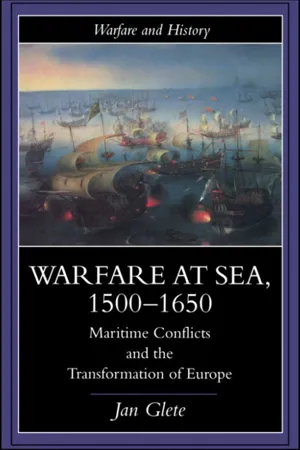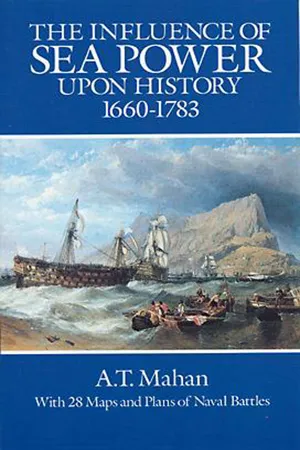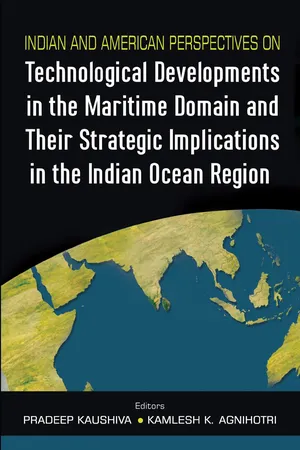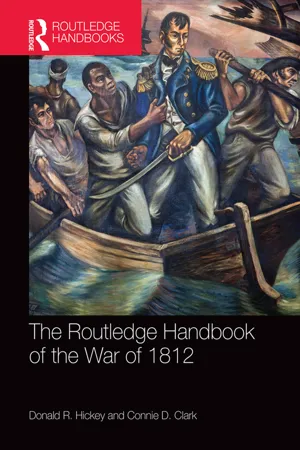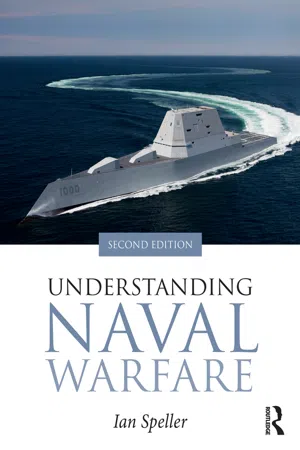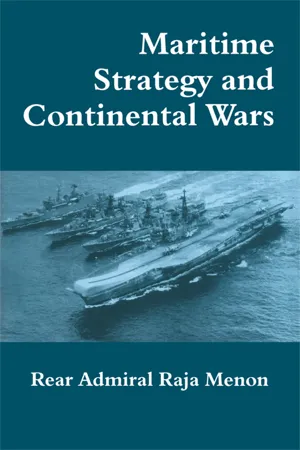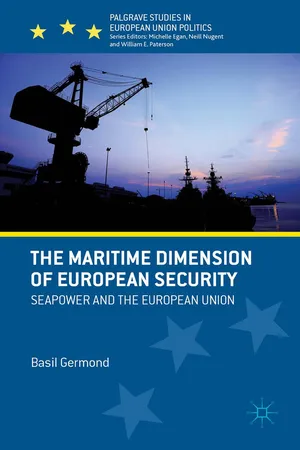History
War on the Sea
The "War on the Sea" refers to naval warfare and battles fought on the world's oceans and seas. Throughout history, nations have engaged in conflicts at sea to gain control of trade routes, protect their territories, and project power. Naval warfare has played a crucial role in shaping the outcomes of many historical conflicts and continues to be a significant aspect of modern military strategy.
Written by Perlego with AI-assistance
Related key terms
Related key terms
1 of 4
Related key terms
1 of 3
7 Key excerpts on "War on the Sea"
- eBook - ePub
Warfare at Sea, 1500-1650
Maritime Conflicts and the Transformation of Europe
- Jan Glete(Author)
- 2002(Publication Date)
- Routledge(Publisher)
maritime lines of communication. These lines are used for trade, for power projection into territories close to the sea and as a source of wealth extracted by violence or through protection from violence. Consequently, wars at sea are fought in the interest of those who use the sea for trade, for the projection of military power and for resource extraction: plunder and taxes. Wars are also fought by those who feel threatened if competing groups are given free access to the sea for such activities. For the defender against seaborne invasion the sea is a forward area for naval operations which aim at delaying and preventing threats against his territory. Wars may have their immediate cause in accidental diplomatic breakdowns, domestic power politics or the vanity of rulers but once started they are shaped by the practical possibilities of inflicting damage on the enemy and giving protection to friends.Up to the late fifteenth century European warfare at sea had a stable character within an institutional framework which was typical for the high and late medieval period (thirteenth to fifteenth centuries).Wars were usually regional and the radius of power projection was limited to Europe and the Mediterranean. Violence was used both by temporarily organised naval forces and by private groups. Permanent navies controlled by states were rare. Territorial powers had only a limited role in warfare at sea which was dominated by independent city states and mercantile interests in loosely integrated territorial states. Warfare at sea was often financed and organised by groups with a direct economic interest in protection or coercion at sea, not by states.This was natural in a period when violence was not the monopoly of sovereigns and when sovereignty over a territory was often divided between central, regional and local power–holders. Wars were waged through social institutions rather than with organisations created by states. Many regions and cities were connected by dynastic bonds or commercial networks which crossed national boundaries. Groups with a strong interest in maritime trade normally had access to concentrated capital, the necessary hardware for war (ships), and a superior know–how in maritime matters. This often gave them a decisive advantage in conflicts over maritime lines of communication. - A. T. Mahan(Author)
- 2012(Publication Date)
- Dover Publications(Publisher)
INFLUENCE OF SEA POWER UPON HISTORY.INTRODUCTORY.
T HE history of Sea Power is largely, though by no means solely, a narrative of contests between nations, of mutual rivalries, of violence frequently culminating in war. The profound influence of sea commerce upon the wealth and strength of countries was clearly seen long before the true principles which governed its growth and prosperity were detected. To secure to one’s own people a disproportionate share of such benefits, every effort was made to exclude others, either by the peaceful legislative methods of monopoly or prohibitory regulations, or, when these failed, by direct violence. The clash of interests, the angry feelings roused by conflicting attempts thus to appropriate the larger share, if not the whole, of the advantages of commerce, and of distant unsettled commercial regions, led to wars. On the other hand, wars arising from other causes have been greatly modified in their conduct and issue by the control of the sea. Therefore the history of sea power, while embracing in its broad sweep all that tends to make a people great upon the sea or by the sea, is largely a military history; and it is in this aspect that it will be mainly, though not exclusively, regarded in the following pages.A study of the military history of the past, such as this, is enjoined by great military leaders as essential to correct ideas and to the skilful conduct of war in the future. Napoleon names among the campaigns to be studied by the aspiring soldier, those of Alexander, Hannibal, and Cæsar, to whom gunpowder was unknown; and there is a substantial agreement among professional writers that, while many of the conditions of war vary from age to age with the progress of weapons, there are certain teachings in the school of history which remain constant, and being, therefore, of universal application, can be elevated to the rank of general principles. For the same reason the study of the sea history of the past will be found instructive, by its illustration of the general principles of maritime war, notwithstanding the great changes that have been brought about in naval weapons by the scientific advances of the past half century, and by the introduction of steam as the motive power.- Pradeep Kaushiva, Kamlesh K Agnihotri(Authors)
- 2013(Publication Date)
- KW Publishers(Publisher)
Compound Warfare: That Fatal Knot (Kansas: US Army Command and General Staff College Press, 2002), 1.16 .Colin S. Gray, War —Continuity in Change and Change in Continuity (New Delhi: USI Digest, vol XIII, no. 25, September 2010), 31. Originally published in Parameters , vol. XXXX, no. 2, Summer 2010.17 .Gary D. Solis, The Law of Armed Conflict: International Humanitarian Law in War (New York: Cambridge University Press, 2010), 257-58.18 .William Owens with Edward Offley, Lifting the Fog of War (New York: Farrar Straus Giroux, 2000), 179.19 .See John J. Mearsheimer, The Tragedy of Great Power Politics (New York: W. W. Norton & Co, 2001), 77-86 for an explanation of this theory.20 . Lawrence Sondhaus, Navies in Modern World History (London: Reaktion Books, 2004), 7.21 .Despite being a non-dictionary word, the term “Navalists” finds widespread use in relation to a particular section of the strategic community who profess maritime preponderance.22 .Edward N. Luttwak, Strategy: The Logic of War and Peace (Massachusetts: Belknap Press, 1987), 156-74.23 .George W. Baer, One Hundred Years of Seapower, The US Navy, 1890-1990 (California: Stanford University Press, 1993), 360.24 .Colin S. Gray, The Leverage of Seapower, The Strategic Advantages of Navies in War (New York: The Free Press, 1992), 289-90.25 .Dudley Wright Knox, The Naval Genius of George Washington (Boston: Riverside Press, 1960 reprint edn.).26 .For a more elaborate discussion on the issue of control of maritime space, see Geoffrey Till, Seapower: A Guide for the Twenty-First Century , 2nd edn. (New York: Routledge, 2009), chapter 6, 145-56.27 .Martin C. Libicki, Conquest in Cyberspace —National Security and Information Warfare (Cambridge: Cambridge University Press, 2007), 16-24.28 .Douglas J. Peters, Stephen Riese, Gray Sauer and Thomas Wilk, “The Hunt for Clues: Collect and Analyze Situation Awareness Data” in Alexander Kott (ed.), Battle of Cognition: The Future Information- eBook - ePub
- Donald R. Hickey, Connie D. Clark(Authors)
- 2015(Publication Date)
- Routledge(Publisher)
4The War on the High SeasAndrew LambertWhile the Naval War of 1812 is a familiar subject, it has suffered from a fractured historiography. The basic American treatment, created by wartime and early postwar Democratic-Republican politicians and publicists, claimed the United States won the war, with the Navy playing a significant part in that victory. This literature focused on surface detail: combat, heroism, and ocean voyages. It addressed the pressing need of the governing party to win the upcoming presidential election, rather than the outcome of the conflict. Yet it was so successful that within two decades President Andrew Jackson brandished his “victorious” navy as a weapon in diplomatic relations with Britain and France, whose navies could have demolished the American fleet and imposed a crippling economic blockade.A very different assessment of the naval war was produced by British lawyer-historian William James. Having collated and analyzed the evidence, James concluded the American victories in single-ship actions, the core of the boasted naval “victory,” were, in all cases, the product of a substantial American superiority in size, manpower, and firepower. More importantly, as Alfred Thayer Mahan argued more than a century ago, it mattered very little who won the occasional frigate battle, so long as British floating commerce continued to move without serious hindrance across the world ocean, enabling the British to fund their war effort. America simply lacked the power to stop British trade. Mahan recognized the overriding importance of economic warfare, the offensive weapon of British sea power against American land power. Blockading ports, seizing commercial shipping at sea, and destroying commercial assets onshore dovetailed perfectly with the defense of British floating trade against American warships and privateers. American cruisers were blockaded or destroyed in port, while the convoy system and cruiser patrols at key landfalls obliged any predators that did get to sea to fight for their prizes. Having waged total economic war against republican and imperial France for almost 20 years, the British simply applied the same strategy to America, extending blockades, convoys, and other countermeasures to address the new threat. The British victory was absolute; by November 1814 the United States was bankrupt: literally unable to pay sailors, shipyard workers, and bondholders. British limited war strategy prevailed. - eBook - ePub
- Ian Speller(Author)
- 2018(Publication Date)
- Routledge(Publisher)
Chapter 2 introduced maritime strategy and focused on an Anglo-American blue water tradition that suggested that success in naval warfare was linked to an ability to secure command of the sea, meaning, in essence, the ability to control maritime communications. Within that tradition the emphasis placed on battle tended to vary. However, and notwithstanding some important differences of nuance and interpretation, the central theme tended to be the importance of the ability to prevail in battle in order to achieve command of the sea, as an enabler for a range of other activities including the protection of trade, blockade of the enemy, and the projection of power ashore. Alternative approaches, that did not focus on achieving command, were usually identified as being a less effective way of waging war.This approach was not the only one on offer. Nor was it necessarily the most appropriate for any but the largest and most powerful navies. It is valid to question the utility of the work of Mahan and those like him for navies that are clearly inferior to their likely adversaries. Weaker navies may have to try something different if they are incapable of securing command in the traditional manner. Following that line of thought, Martin Murphy and Toshi Yoshihara have argued that often navies facing a larger foe have shown a similarity in response that suggests that there may be a ‘universal logic with respect to the naval strategy of the weaker side’.1 This logic tends to revolve around the denial of enemy use of the sea through a mix of coastal defence, limited local sea control and commerce raiding. This chapter will explore that alternative tradition.Commerce raiding
Commerce raiding, or guerre de course (war of the chase) as it is commonly known, had been a feature of naval warfare throughout history. Attacks on trade by com missioned warships or by private vessels (privateers) authorised by a letter of marque to conduct such attacks on behalf of the state had been a common and often, for individual ships, a very profitable way of bringing the war to bear against an enemy. Indeed, up until the seventeenth century, when ships lacked the sea keeping and endurance to maintain an effective blockade, it was one of the few ways of disrupting enemy trade short of actually landing at the point of embarkation or disembarkation. In practice, it was often difficult to differentiate the legal activities of privateers and the illegal predations of pirates , and both figured prominently in English naval activity in the early modern period. Nicholas Rodger has demonstrated the problems that this caused the English, not least in their relations with states whose ships suffered piratical attack and, while in later centuries the English (and from 1707 the British) would focus less on guerre de course and more on blockade, the outrage felt by neutrals whose shipping was harassed or attacked has remained a constant feature of economic warfare at sea, and has often acted as a constraint on both raider and blockader.2 - eBook - ePub
- Rear Admiral K. Raja Menon(Author)
- 2013(Publication Date)
- Routledge(Publisher)
4 The Navy and War on the Economy DOI: 10.4324/9780203815182-4 In a continental war, in countries with substantial coastlines, the use of navies to attack the wartime economies of the enemy could be an attractive option. Of course, in the case of island powers or nations almost totally surrounded by the sea, the war on the economy could well be one of the primary options. Since we are discussing continental wars and admirals still have to find uses for their navies in such wars, their problem in defining a valid maritime strategy could perhaps be solved by an attempt to strike at the economy of the enemy. If the armies are engaged sufficiently near to the coast for an amphibious intervention to be effective, that would form a higher priority option. The gradual transformation of war from an activity in which only uniformed people participated into a national activity took place in the post-Napoleonic period, at least in land fighting. At sea, the priorities have been different. Since time immemorial navies have often treated enemy commerce as a more worthwhile target than enemy warships. The conclusion of a campaign at sea was often summed up statistically in terms of enemy merchantmen and goods captured or destroyed. The success of the English navy in destroying Dutch commerce in the seventeenth century was studied by French maritime strategists of the jeune école, who transplanted the idea of attacking English commerce as the primary maritime strategy for winning a war against England. Nations with coastlines would be likely to have built up a degree of overseas commerce, the denial or destruction of which could be hurtful. New nations, and those released from the colonial grip in the last half-a-century, may not have had sufficient time to have built up their own merchant marine, port infrastructure and the same volume of commerce traditionally enjoyed by independent maritime nations; hence their dependence on the sea would not be uniform - eBook - ePub
The Maritime Dimension of European Security
Seapower and the European Union
- B. Germond(Author)
- 2015(Publication Date)
- Palgrave Macmillan(Publisher)
.] important is the position of each navy relative to the others’ (Jackson, 2010: 12), or in other words the naval balance between states. Traditional naval scholars have mainly focused on the technical, tactical, operational, and strategic aspects of naval warfare. As pointed out by Rear Admiral J. Richard Hill, classical writers such as Mahan, Colomb, Corbett, or Castex were all interested in war and dominance; their focus was on the command of the sea and the importance of the decisive battle (Hill, 1986: 34–35). Accordingly, in his Future of Sea Power, Eric Grove basically defines seapower as a ‘form of military power that is deployed at or from the sea’ (Grove, 1990: 3). Naval build-up before the First World War and the naval arms race during the Cold War illustrate the realist vision of seapower. In both cases, powerful states developed their navies so as to be in a position of strength in comparison with their competitors in case of hostilities – the more ships the better and the more powerful weapon systems the better. Since the 1960s, despite the huge effort put in by the Soviets in developing their navy, the US and NATO member states had kept a favourable balance of power at sea, which was an important factor that contributed to the fall of the Soviet Union – the cost of developing and maintaining an operational navy of that size eventually became an economic burden for the Soviet Union. Despite the recent resurgence of a potential ‘Russia threat’, in the post-Cold War era, the realist vision has been challenged by the expansion of the security agenda, notably the taking into account of various so-called ‘new threats’, which mainly result from the growth of non-state actors (e.g. terrorism at sea, piracy), as well as the increasing occurrence of foreign interventions (mainly humanitarian and peace support operations) not always motivated by pure considerations of power
Index pages curate the most relevant extracts from our library of academic textbooks. They’ve been created using an in-house natural language model (NLM), each adding context and meaning to key research topics.
Explore more topic indexes
Explore more topic indexes
1 of 6
Explore more topic indexes
1 of 4
